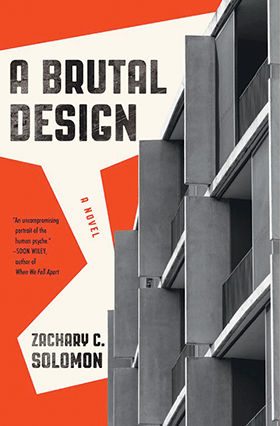Reviewed by NEAL GENDLER
Samuel Zelnik flees a deadly, fascist state only to discover that the supposedly egalitarian utopia to which he’s fled isn’t what it seems.
One of the strangest novels I’ve ever read, A Brutal Design is perfectly titled on two levels: the architecture and the concealed reality.
But first, a bit of the story, which is told in the first person — and except for descriptions of architecture, so sparingly that author Zachary Solomon leaves readers with questions that get answered only late in the book, if at all.
Zelnik is in an unnamed country that apparently has become brutally fascist. He is an orphan raised by a slovenly, unemployed, uncaring uncle who disappears.
As the book opens, he’s nearing the end of a long train trip, traveling with a bag he wasn’t allowed to pack for himself, rolling through a hot, dusty area he calls “the infinite steppe.” He’d agreed to this relocation, he says, “but then again, is there really a decision if the alternative is intolerable?”
We learn that Zelnik is an architect who was nearing conclusion of graduate school at Barnova, known for graduating “activist intellectuals.” But it has become right wing. “Its more progressive departments were defunded,” aging humanities professors were replaced by teachers of questionable credentials, and one of his favorites, Miriana Grannoff, “famously a lefty artist,” was gone.
Zelnik and a few other students were trying to organize a resistance movement when almost all were killed. Zelnik knows that he must flee, lest he be imprisoned or murdered like “my loyal Socialist parents,” burned to death in their synagogue as he and his uncle watched from across the street.
His destination is Duma, an experimental city in the desert. He’s been told he’ll replace Duma’s recently deceased architect.
“If the ethos behind this place was a progressive one … then I wanted to contribute,” Zelnik says. A driver meets his train, telling him: “At Duma, we try to get rid of differences between people.’’ Residents are not to discuss their pasts and encouraged to speak only English.
Zelnik tells him his uncle wrote to say he lives there as a chemical engineer. Zelnik hopes to meet with him.
Paradise quickly goes awry. He’s assigned to manual labor in a factory holding two columns of about 20 rows of “long, contiguous worktables. Men and women in gray jumpsuits stand or sit eight per table, four per side, working with parts and tools.”
The job is to connect metal parts into a plumbing-like device, fill a crate with the completed assemblies, empty it and fill another one. He decides to make a game of it, seeing if he can complete more assemblies per hour than the woman across from him.
On one basket-emptying trip, his jacket, once his uncle’s, “the one item that I had with me that still tethered me to my home,” gets caught in the conveyor belt gears. Half is torn off and disappears. He’s overcome with grief. His co-workers pay no attention.
Zelnik soon stops showing up for work and wanders around Duma, heading for a hill with “short, modular homes … small-enough to be single-family homes but big enough to be impressive.” There he discovers Erich Snelling, formerly an odd classmate. Snelling apparently has a high-placed job and offers to get Zelnik moved if he’ll find out who has been printing pamphlets considered subversive.
As he wanders, Zelnik finds disturbing art works by Grannoff, one framing an entrance to a place he is not supposed to go. He enters, and matters worsen.
A Brutal Design certainly denounces fascism and may hold meanings others will find. It’s also something of a mystery novel: At one level, one wonders what in the world is going on, and at another level, people are not who they seem to be.
Promotional material told me that Duma has a dark side, and in his very sparse style, Solomon manages to create a sinister atmosphere from the first pages. That’s quite an accomplishment, although I wonder if a reader knowing nothing in advance would get the same feeling.
Duma was the name of the Russian parliament from 1906 until the Bolsheviks took over and created an absolute dictatorship. The book’s publicist says that it’s intended instead as meaning “to think.”
The title is perfect: Duma’s buildings, except for the appropriately named Crescent where Zelnik is assigned a small room, are brutalist style. And as we slowly learn, this supposedly egalitarian utopia of contented workers conceals its own brutality.
Solomon engages and holds your attention, any author’s achievement. But I criticize his use of obscure words: more than half a dozen not even in the 77,000-word American Heritage dictionary next to my reading chair.
Sometimes a little-known word is justifiable, conveying a precise meaning that other words don’t. My argument is that a writer who wants to deliver a message should use language readily understood by the target audience.
But don’t let distracting trips to the dictionary dissuade you from this compelling, unsettling vision of a future few of us want.
***
Neal Gendler is a Minneapolis writer and editor.
(American Jewish World, May 2024)




















